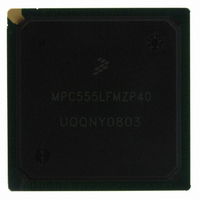MPC555LFMZP40 Freescale Semiconductor, MPC555LFMZP40 Datasheet - Page 701

MPC555LFMZP40
Manufacturer Part Number
MPC555LFMZP40
Description
IC MCU 32BIT 40MHZ 272-BGA
Manufacturer
Freescale Semiconductor
Series
MPC5xxr
Datasheets
1.MPC555LFMZP40.pdf
(12 pages)
2.MPC555LFMZP40.pdf
(966 pages)
3.MPC555LFMZP40.pdf
(3 pages)
Specifications of MPC555LFMZP40
Core Processor
PowerPC
Core Size
32-Bit
Speed
40MHz
Connectivity
CAN, EBI/EMI, SCI, SPI, UART/USART
Peripherals
POR, PWM, WDT
Number Of I /o
101
Program Memory Size
448KB (448K x 8)
Program Memory Type
FLASH
Ram Size
26K x 8
Voltage - Supply (vcc/vdd)
2.5 V ~ 2.7 V
Data Converters
A/D 32x10b
Oscillator Type
External
Operating Temperature
-40°C ~ 125°C
Package / Case
272-PBGA
Controller Family/series
POWER 5xx
Ram Memory Size
26KB
Cpu Speed
63MIPS
Embedded Interface Type
QSPI, SCI, TouCAN
Operating Temperature Range
-40°C To +125°C
No. Of Pins
272
Rohs Compliant
No
Processor Series
MPC5xx
Core
PowerPC
Data Bus Width
32 bit
Data Ram Size
26 KB
Interface Type
CAN, QSPI, SCI
Maximum Clock Frequency
40 MHz
Number Of Programmable I/os
101
Operating Supply Voltage
3.3 V to 5 V
Maximum Operating Temperature
+ 125 C
Mounting Style
SMD/SMT
Development Tools By Supplier
MPC555CMEE
Minimum Operating Temperature
- 85 C
On-chip Adc
10 bit, 32 Channel
Cpu Family
MPC55xx
Device Core
PowerPC
Device Core Size
32b
Frequency (max)
40MHz
Total Internal Ram Size
32KB
# I/os (max)
101
Operating Supply Voltage (typ)
5V
Instruction Set Architecture
RISC
Operating Temp Range
-40C to 85C
Operating Temperature Classification
Industrial
Mounting
Surface Mount
Pin Count
272
Package Type
BGA
For Use With
MPC555CMEE - KIT EVAL FOR MPC555
Lead Free Status / RoHS Status
Contains lead / RoHS non-compliant
Eeprom Size
-
Lead Free Status / Rohs Status
No
Available stocks
Company
Part Number
Manufacturer
Quantity
Price
Company:
Part Number:
MPC555LFMZP40
Manufacturer:
MOTOLOLA
Quantity:
853
Company:
Part Number:
MPC555LFMZP40
Manufacturer:
Freescale Semiconductor
Quantity:
10 000
Company:
Part Number:
MPC555LFMZP40R2
Manufacturer:
Freescale Semiconductor
Quantity:
10 000
- Current page: 701 of 966
- Download datasheet (15Mb)
21.2.3 Sequential Instructions Marked as Indirect Branch
21.2.4 The External Hardware
21.2.4.1 Synchronizing the Trace Window to the CPU Internal Events
MPC555
USER’S MANUAL
cases the first instruction fetch after debug mode is marked with the program trace cy-
cle attribute and therefore is visible externally.
There are cases when non-branch (sequential) instructions may effect the machine in
a manner similar to indirect branch instructions. These instructions include rfi, mtmsr,
isync and mtspr to CMPA-F, ICTRL, ECR and DER.
These instructions are marked by the CPU as indirect branch instructions (VF = 101)
and the following instruction address is marked with the same program trace cycle at-
tribute as if it were an indirect branch target. Therefore, when one of these special in-
structions is detected in the CPU, the address of the following instruction is visible
externally. In this way the reconstructing software is able to evaluate correctly the ef-
fect of these instructions.
When program trace is needed, the external hardware needs to sample the status pins
(VF and VFLS) each clock cycle and the address of all cycles marked with the program
trace cycle attribute.
Program trace can be used in various ways. Below are two examples of how program
trace can be used:
The assertion/negation of VSYNC is done using the serial interface implemented in the
development port. In order to synchronize the assertion/negation of VSYNC to an in-
• Back trace — Back trace is useful when a record of the program trace before
• Window trace — Window trace is useful when a record of the program trace be-
/
some event occurred is needed. An example of such an event is some system
failure.
In case back trace is needed the external hardware should start sampling the sta-
tus pins (VF and VFLS) and the address of all cycles marked with the program
trace cycle attribute immediately when reset is negated. If show cycles is pro-
grammed out of reset to show all, all cycles marked with program trace cycle at-
tribute are visible on the external bus. VSYNC should be asserted sometime after
reset and negated when the programmed event occurs. If no show is pro-
grammed for show cycles, make sure VSYNC is asserted before the Instruction
show cycles programming is changed from show all.
Note that in case the timing of the programmed event is unknown it is possible to
use cyclic buffers.
After VSYNC is negated the trace buffer will contain the program flow trace of the
program executed before the programmed event occurred.
tween two events is needed. In case window trace is needed the VSYNC pin
should be asserted between these two events.
After the VSYNC pin is negated the trace buffer will contain information describing
the program trace of the program executed between the two events.
MPC556
Freescale Semiconductor, Inc.
For More Information On This Product,
DEVELOPMENT SUPPORT
Go to: www.freescale.com
Rev. 15 October 2000
MOTOROLA
21-5
Related parts for MPC555LFMZP40
Image
Part Number
Description
Manufacturer
Datasheet
Request
R
Part Number:
Description:
Manufacturer:
Freescale Semiconductor, Inc
Datasheet:
Part Number:
Description:
Manufacturer:
Freescale Semiconductor, Inc
Datasheet:
Part Number:
Description:
Manufacturer:
Freescale Semiconductor, Inc
Datasheet:
Part Number:
Description:
Manufacturer:
Freescale Semiconductor, Inc
Datasheet:
Part Number:
Description:
Manufacturer:
Freescale Semiconductor, Inc
Datasheet:
Part Number:
Description:
Manufacturer:
Freescale Semiconductor, Inc
Datasheet:
Part Number:
Description:
Manufacturer:
Freescale Semiconductor, Inc
Datasheet:
Part Number:
Description:
Manufacturer:
Freescale Semiconductor, Inc
Datasheet:
Part Number:
Description:
Manufacturer:
Freescale Semiconductor, Inc
Datasheet:
Part Number:
Description:
Manufacturer:
Freescale Semiconductor, Inc
Datasheet:
Part Number:
Description:
Manufacturer:
Freescale Semiconductor, Inc
Datasheet:
Part Number:
Description:
Manufacturer:
Freescale Semiconductor, Inc
Datasheet:
Part Number:
Description:
Manufacturer:
Freescale Semiconductor, Inc
Datasheet:
Part Number:
Description:
Manufacturer:
Freescale Semiconductor, Inc
Datasheet:
Part Number:
Description:
Manufacturer:
Freescale Semiconductor, Inc
Datasheet:











